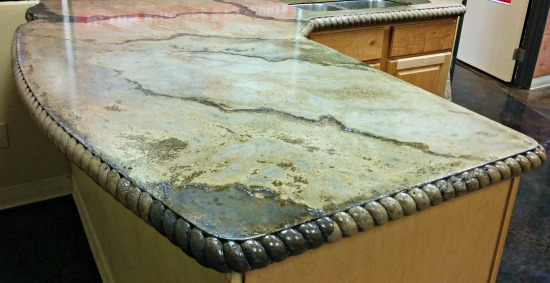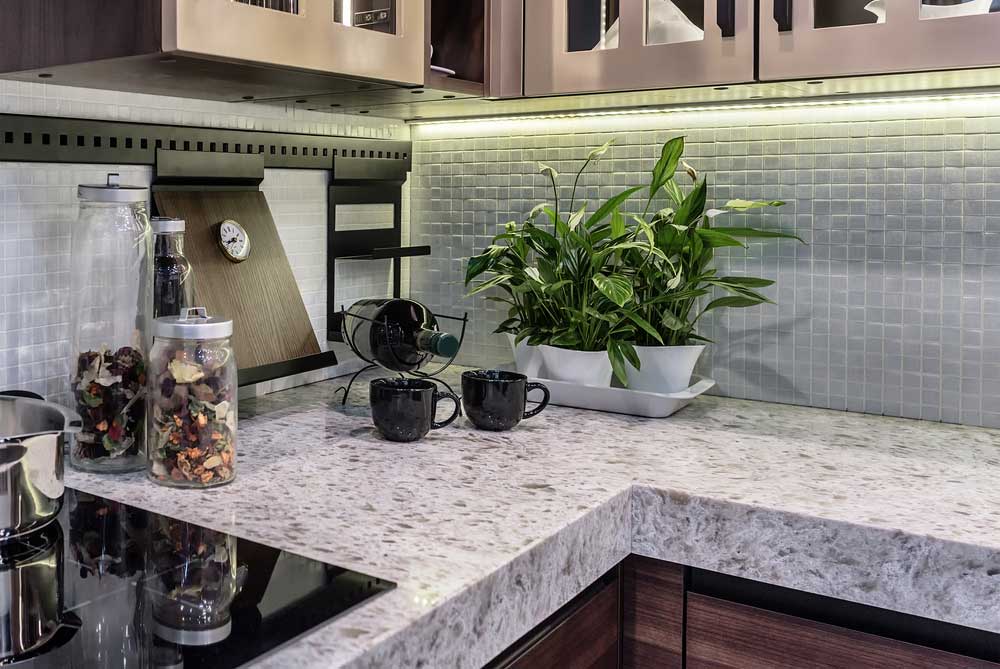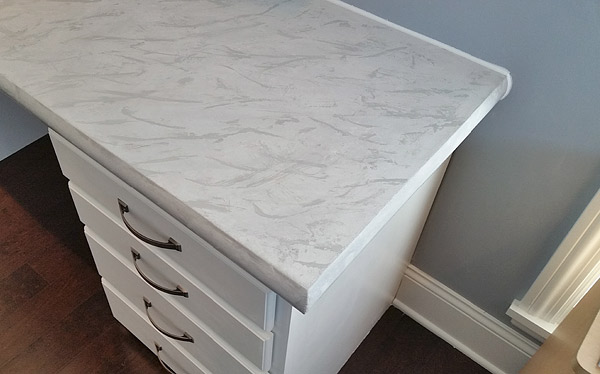Creating concrete countertops that look like marble is an innovative and cost-effective way to achieve a luxurious aesthetic without the high price tag associated with natural marble. This process involves careful planning, preparation, and a variety of techniques to mimic the unique veining and coloration of marble. The result is a stunning countertop that combines the durability of concrete with the timeless beauty of marble.
The first step in making concrete countertops look like marble is choosing the right concrete mix. High-quality concrete mixes designed for countertops are essential, as they offer the necessary strength and smoothness. These mixes often include fine aggregates and additives that enhance workability and reduce the risk of cracks. Ensuring the concrete is properly mixed and poured is crucial for achieving a solid foundation for the faux marble finish.
After pouring the concrete, it’s important to create a smooth, even surface. This can be achieved through a process called screeding, where a straightedge is used to level the concrete. Once the concrete is leveled, troweling the surface will help to eliminate any air bubbles and imperfections, creating a smooth canvas for the marbleizing process. Proper curing of the concrete is essential, as it allows the countertop to reach its full strength and durability.
Once the concrete has cured, the next step is to prepare the surface for staining and veining. This involves sanding the countertop to ensure a perfectly smooth finish. Using progressively finer grits of sandpaper, or a concrete polisher, will help achieve a glass-like surface that will readily accept stains and sealers. Cleaning the countertop thoroughly to remove all dust and debris is critical for ensuring the best adhesion of the stains.
The key to creating a marble-like appearance on concrete is the use of stains and dyes. Water-based or acid-based stains can be used to achieve a range of marble colors, from classic white and grey to more exotic hues. The application technique is crucial; using sponges, brushes, and sprayers can help to create the natural variations and veining characteristics of marble. Layering different colors and using a variety of application methods can produce depth and realism in the faux marble finish.

For the veining, a technique called feathering is often employed. This involves using a fine brush or feather to apply a darker stain in thin, irregular lines that mimic the natural veining found in marble. The lines should be random and varied in thickness to create a realistic look. Practicing on a sample piece of concrete before working on the actual countertop can help refine this technique.
To enhance the marble effect, some artisans use a technique called wet-on-wet staining, where multiple colors are applied while the initial stain is still wet. This allows the colors to blend and swirl naturally, mimicking the fluid patterns of marble. Another method is to use a plastic wrap or bag to create texture by pressing it into the wet stain and then removing it, leaving behind organic, marble-like patterns.
Once the staining and veining are complete, it’s essential to seal the countertop to protect the finish and enhance the colors. There are various types of sealers available, including penetrating sealers, which soak into the concrete and protect from within, and topical sealers, which form a protective layer on the surface. A high-gloss sealer is often preferred for a marble look, as it enhances the depth of color and provides a polished, marble-like sheen.

Applying multiple coats of sealer can enhance the durability and appearance of the countertop. Each coat should be allowed to dry thoroughly before applying the next. Polishing the countertop between coats can also help to achieve a smoother, more reflective surface. For the best results, follow the manufacturer’s instructions for the specific sealer used.
Maintaining the look of a concrete countertop that resembles marble requires regular care and maintenance. Cleaning should be done with mild, non-abrasive cleaners to avoid damaging the sealer. Reapplying the sealer periodically, depending on the level of use, will help maintain the protective finish and keep the countertop looking its best.
This process of transforming concrete into a marble-like surface is not only cost-effective but also offers the flexibility to customize the look to match specific design preferences. Whether aiming for the classic elegance of white Carrara marble or the dramatic look of black marble with white veining, the possibilities are virtually endless. Customizing the color and pattern can result in a unique piece that enhances the overall design of the kitchen or bathroom.
In addition to kitchens and bathrooms, marble-like concrete countertops can be used in various settings, including outdoor kitchens, bars, and laundry rooms. Their durability makes them suitable for a range of environments, and the custom marble finish adds a touch of elegance and sophistication. This versatility makes them a popular choice for homeowners looking to enhance the aesthetic appeal of their spaces.
Moreover, creating concrete countertops that look like marble can be an engaging DIY project for those who enjoy home improvement. While it requires a fair amount of skill and patience, the satisfaction of creating a beautiful, custom countertop can be highly rewarding. There are numerous tutorials and resources available to guide DIY enthusiasts through the process, making it accessible to a broader audience.
Ultimately, the combination of concrete’s durability and the luxurious look of marble makes this approach an attractive option for many homeowners. Whether for new construction or renovation projects, marble-look concrete countertops offer a unique blend of beauty, practicality, and affordability. By carefully following the steps outlined above and avoiding common mistakes, it is possible to achieve a stunning, high-end look that will stand the test of time.

Common Mistakes to Avoid
One common mistake is neglecting proper surface preparation. Failing to sand and clean the concrete thoroughly can result in uneven staining and poor adhesion of the sealer. It’s crucial to invest time in sanding the surface to a smooth finish and removing all dust and debris before applying stains or dyes.
Another mistake is using the wrong type of stain or dye. Not all stains are suitable for creating a marble look. Water-based stains offer more control and subtle color variations, while acid stains can produce more dramatic effects. Understanding the differences and choosing the appropriate stain for the desired outcome is essential.
Applying stains too heavily can also be problematic. Over-saturating the surface can lead to blotchy and unrealistic patterns. It’s better to apply multiple light coats, allowing each to dry before adding more, to build up color gradually and achieve a more natural look.
Inadequate sealing is another common error. Skipping the sealer or using a low-quality product can leave the countertop vulnerable to stains and damage. A high-quality, high-gloss sealer is recommended to protect the finish and enhance the marble-like appearance.
Finally, failing to maintain the countertop properly can lead to premature wear and loss of the marble effect. Regular cleaning with non-abrasive cleaners and periodic resealing is necessary to keep the countertop looking its best. Neglecting these maintenance steps can result in a dull and damaged surface.

What are the benefits of creating concrete countertops that look like marble?
Creating concrete countertops that look like marble offers several benefits. It provides the luxurious appearance of marble at a fraction of the cost. Concrete is highly durable, making it suitable for high-use areas like kitchens and bathrooms. Additionally, concrete can be customized in terms of color and pattern, allowing for a unique and personalized look that natural marble cannot always provide. This combination of affordability, durability, and customization makes it an attractive option for many homeowners.
How do I ensure a smooth and even surface for staining?
To ensure a smooth and even surface for staining, start by properly mixing and pouring the concrete to avoid air pockets and imperfections. Once the concrete has cured, sand the surface using progressively finer grits of sandpaper or a concrete polisher until it is smooth and free of blemishes. Thoroughly clean the countertop to remove all dust and debris, which can interfere with stain adhesion. Taking these steps will create an ideal surface for applying stains and achieving a realistic marble effect.
What types of stains are best for creating a marble look on concrete countertops?
Water-based stains and dyes are often preferred for creating a marble look on concrete countertops because they offer better control over color application and blending. These stains can be layered and manipulated to achieve the subtle color variations and veining typical of marble. Acid stains can also be used but tend to produce more intense and less controllable effects. It’s essential to choose stains that are compatible with concrete and suitable for the specific aesthetic you are aiming to achieve.
How do I create realistic marble veining on my concrete countertop?
Creating realistic marble veining involves using a fine brush or feather to apply darker stains in thin, irregular lines. This technique, known as feathering, helps mimic the natural veining of marble. To add depth and realism, you can layer multiple colors and use a wet-on-wet staining method, where additional colors are applied while the initial stain is still wet, allowing them to blend naturally. Practicing on a sample piece of concrete can help perfect this technique before applying it to the actual countertop.
How do I maintain my concrete countertop to keep it looking like marble?
Maintaining a concrete countertop to keep it looking like marble involves regular cleaning with mild, non-abrasive cleaners and avoiding harsh chemicals that can damage the sealer. Periodically resealing the countertop is necessary to maintain the protective layer and preserve the marble-like finish. Using cutting boards and trivets will protect the surface from scratches and heat damage. By following these maintenance steps, you can keep your concrete countertop looking beautiful and marble-like for years to come.
How to Make Concrete Look Like Marble – 7 Easy Steps to Follow

Concrete Countertops Come Alive After Dark – Concrete Decor

Decided To Pour My Own Concrete Countertops

Creative Concrete Countertop Designs –

Concrete Flooring Associates on Concrete Countertops

Artistic Countertops & Coatings Llc

Related articles:
- How To Refinish Concrete Countertop
- Concrete Countertops How To Make
- How To Make A Concrete Countertop With Sink
- DIY Concrete Countertops Over Tile
- DIY Concrete Countertops Bathroom
- Maintaining Concrete Countertops
- How To Make Concrete Countertops Look Like Marble
- Removing Concrete Countertops
- Curved Concrete Countertop Forms
- Edge Forms For Concrete Countertop